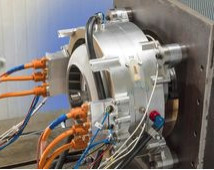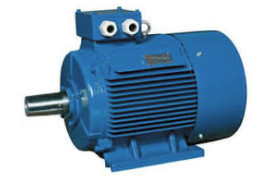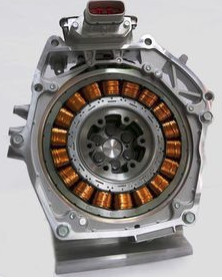Anybody can bolt a (say) 150-250HP 3 phase electric motor onto a GA plane and put a prop on the front of it. This has not changed significantly – in terms of 3 phase motor technology – in the best part of 100 years. The motors proposed for GA use are just built with thin casings and a different mounting system

whereas traditional motors are mounted by the case and this is a heavy casting with lugs on the bottom

Fully electric cars use a similar multipole layout to the aircraft layout

Then you exhibit it at Aero Friedrichshafen and look for an EU development grant 
The challenge is the batteries and charging them…
Rare earth magnets are new – they make brushless high power motors possible. But in essence I agree with you. The motor side of things is solved. The battery aspects aren’t.
It is probably true that fixed magnet motors are most suitable for the constant power application in aircraft, but the case for magnets, versus induction, is less than clear.
Current article on the topic – here
I agree with the assessment that small airplanes (the article mentions only air taxis as if there was no recreational GA) could be all-electric right now (for short ranges), short-haul CAT could be in a few decades and for long-range it is not yet concieveable.
Thanks Peter, for an interesting article. The other point I’d make re. brushless motors is that they have no commutators which is likely to be good for reliability. Also that brushless motors are generally considerably lighter – this article suggests 50 v. 70kg for the active components in brushless v. brushed.
Another article comparing brushed v. brushless
Both permanent magnet motors and induction motors are brushless.
I am no motor expert but it appears that the induction motor has the advantage of having a low level of flux at low rpm (which gives smoother rotation at low rpm) and this is what led Tesla to use it, but it is probably less relevant to aviation where low rpm is not used.
Brush motors are used with the ancient commutator to make a simple DC motor but few modern high value high power applications use these (most industrial apps use 3 phase motors driven from a variable frequency inverter). Brush motors which use slip rings (usually for the field current, with a 3 phase motor) are a lot better because the brushes wear slower but I doubt that powered field coils have any advantage over either magnets or induction IF sophisticated electronic control is available.
Magnets are very heavy though. I suspect the brushless induction motor is 20kg lighter than the brushless permanent magnet motor.
Parker is one of many companies making AC drives (inverters) for 3 phase motors.
kwlf wrote:
Also that brushless motors are generally considerably lighter – this article suggests 50 v. 70kg for the active components in brushless v. brushed.Yes, the brushed motors in the link that you posted have no place in aviation. At 72 kg the specific power achieved is a meagre 0.9 kW / kg. The brushless motor discussed in your link achieves 4.3 kW/kg, which is better. Siemens is onto something with their motors achieving 5.2 kW/kg.
kwlf wrote:
The motor side of things is solved. The battery aspects aren’t.Bloomberg expects battery prices to drop to $162 /kWh this year and down to $ 73/kWh in a decade. This solves the price side of things. Battery weight remains a challenge. Sun Flyer offsets this by adding solar panels reducing battery size. Rolls Royce is now experimenting with a turbine-generator in the tail greatly reducing battery need. The next few years are going to be interesting.
I really like this reality: an 80 hp aero engine, one moving part!!!
Rolls Royce is now experimenting with a turbine-generator in the tail greatly reducing battery need
How is this supposed to work? Surely you are better off burning fuel in a jet engine which pushes the plane, than burning fuel in a jet engine which drives an alternator which drives a load of electronics which charge a battery which drives another load of electronics which controls the power to an electric motor which drives a “propeller”. No matter how you shake this, hybrid power trains don’t make sense in constant high power applications, such as aircraft.
For sure a permanent magnet motor has only one moving part but it needs a lot of electronics to control it. There are many issues in the reliability of that stuff. It involves high currents, so generates heat, which needs to be dissipated, but the thermal cycling of the power semiconductors means their life is not going to be anywhere near infinite. It can be pretty good but is it much higher than the simple mechanical controls on say a jet engine? I can’t say but having been in electronics, and often power electronics, since the 1970s, I suspect probably not. There are also various sensors… the failure of any of which potentially stops the whole thing.
BTW I did a quick google on 250HP old style 3 phase motors and as expected they are heavy – over 1000kg. 100HP is about 500kg. So sticking in an off the shelf industrial motor was not the way forward. OTOH the way forward in motors would have been obvious to anyone flying a model plane.
kwlf wrote:
1) Electric motors don’t need much cooling
they still need sufficient cooling — several kW of thermal energy, from much smaller & lighter package than conventional piston engine (while that one has much worse efficiency, a lot of heat is neatly carried away in the exhaust gases) in a quite tight space.
Compare e.g. with Pipistrel Alpha, which has a clear cooling intake (
0:24). And no, they did not just copy the intake of Virus SW, those are quite different. If they could go away without it, they would have surely avoided that intake – after all, Pipistrel is known for good/careful aerodynamics/efficiency. And that is 50kW, vs 80/120kW for SunFlyer,
Estimated Time of Arrival for electric planes: 2045
https://www.wired.com/2017/05/electric-airplanes-2/
It’s going to be Lycos and Contis for the next 50 years, or with some luck an EPS Diesel.